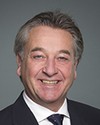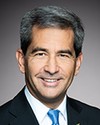Mr. Chair and committee members, good morning. My name is Lieutenant-General Stephen Bowes, and it is my pleasure to be here today to discuss Canadian Armed Forces' operations and activities in the Arctic.
I am accompanied by Brigadier-General Mike Nixon, who is the commander of Joint Task Force North, which is responsible for the planning and conduct of operations in the north, including the Arctic.
As you know, Canada's Arctic region is immense. It comprises some 40% of Canada's overall land mass, and 75% of its coastline. Its size, combined with its austere climate and conditions, present a complex environment in which the Canadian Armed Forces must be prepared to operate at any time.
To give you a sense of the challenge, General Nixon's area of operations spans four time zones, with harsh terrain, limited daylight, and poor weather conditions for much of the year, with time and space posing a significant challenge in providing a response.
The Canadian Arctic is expected to experience an increase in overall activity in the coming years due to developments in areas such as natural resource exploitation, adventure activities and maritime traffic; this in turn would likely give rise to new requirements for support from the Canadian Armed Forces, such as search and rescue and supporting civilian authorities in consequence management.
The Canadian Armed Forces make a vital contribution to the fulfilment of Government of Canada priorities in the Arctic. Our tasks include demonstrating a visible presence to exercise sovereignty, conducting surveillance and control of Canadian territory and approaches, carrying out search and rescue operations, and providing assistance to government partners when called upon.
As confirmed in the Prime Minister mandate letter to the Minister of National Defence, the Arctic remains a Government of Canada priority. The specific roles and activities of the Canadian Armed Forces in the Arctic are, however, being examined as part of the ongoing defence policy review.
As commander of the Canadian Joint Operations Command, I'm responsible for exercising command and control of all Canadian Armed Forces operations, including those in the Arctic. Those are two very important categories, NORAD and Canadian Special Operations Forces Command.
The Canadian Armed Forces maintains a presence and can bring to bear specific capabilities in order to operate in the north. As I already mentioned, Joint Task Force North, under General Nixon's command, is based in Yellowknife, with detachments in Whitehorse and Iqaluit, as one of six regional task forces under the umbrella or our Joint Operations Command.
Joint Task Force North is responsible for conducting routine and contingency operations in the north and also for the development of the Canadian rangers and Junior rangers programs in the north. Joint Task Force North also liaises with the territorial, municipal, and indigenous governments in order to prepare for rapid and effective responses to emergencies.
The Canadian rangers are a subcomponent of the Canadian Armed Forces reserve. They play a central role in the Canadian Armed Forces tasked to demonstrate visible presence and exercise Canadian sovereignty in the Arctic. The Canadian rangers are currently approximately 5,000 strong in remote locations across Canada, including about 1,700 with 1 Ranger Patrol Group, which is responsible for the Canadian north. Rangers possess unique skills, local knowledge, and expertise that allow them to carry out a wide array of tasks as part of their regular duties, including search and rescue, north warning site patrols, community evacuations, and flood and fire watch. The Canadian rangers are truly the eyes, ears, and voice of the Canadian Armed Forces throughout Canada's north. As such, they also report on both routine and extraordinary activities, such as the presence of suspicious vessels.
The Canadian Armed Forces Arctic training centre, in Resolute Bay, operated in partnership with Natural Resources Canada, provides a facility capable of supporting individual and collective Arctic cold weather training. The training centre, which can accommodate about 140 personnel, also has the capability to serve as a forward operating base if needed.
The Canadian Forces station Alert, under the command of the RCAF, the Royal Canadian Armed Forces, is a signals intelligence facility designed primarily to provide situational awareness in support of military operations. It also possesses a geo-location capability that can assist with search and rescue missions, as well as support to research conducted by other government departments in the Arctic. You will have already heard about other capabilities National Defence and the Canadian Armed Forces can leverage in support of its Arctic activities, such as the north warning system and NORAD's forward operating locations in the north.
In terms of operations, the Canadian Armed Forces conduct three major operations each year, which generally take place in the high, western, and eastern Arctic: Operation Nanook, Operation Nunalivut, and Operation Nunakput. Operation Nanook is the Canadian Armed Forces' largest annual exercise, which integrates participation from the Canadian Army, the Royal Canadian Navy, and the Royal Canadian Air Force, as well as whole-of-government partners. The main effort of Operation Nanook 2016 will focus on a response to an earthquake event in the Yukon territory, with a defence scenario being conducted in vicinity of Rankin Inlet in Nunavut.
Notably, Op NANOOK 15 included a firefighting scenario in which Canadian Armed Forces operated with federal, territorial and municipal agencies in response to a simulated wildfire in the town of Fort Smith.
That has underscored how these training scenarios help prepare our forces for real-world events, as Canadian Armed Forces have deployed to support the current response to the wildfire in the Fort McMurray area.
Operation Nunalivut is a sovereignty-based exercise that employs southern-based Canadian Armed Forces elements as well as the Canadian rangers in High Arctic operations in the challenging period of late winter.
Finally, Operation Nunakput takes place in the western Arctic each summer to exercise sovereignty and interoperability with our RCMP, Department of Fisheries and Oceans, and Coast Guard partners.
In addition to these flagship exercises, the Canadian Armed Forces continues to train through a series of cold-weather, resupply, maintenance, and surveillance exercises each year to ensure that we are ready and have the necessary situational awareness to operate in the Arctic environment.
To support the execution of these operations, and to synchronize and coordinate Canadian Armed Forces activities in the region overall, the Canadian Joint Operations Command has developed a plan for the North. This is a five-year plan which incorporates our operational activities with associated infrastructure and capability requirements as well as engagement with whole-of-government and international partners. The current plan looks out to the year 2020.
Finally, as you will have heard throughout my remarks, the Canadian Armed Forces works in close co-operation with other federal, provincial, territorial, municipal, and indigenous government partners as well as our regional allies to ensure we are delivering on the government's commitments and priorities in the Arctic. For the Armed Forces, that can range from support to consequence management in the north to providing support in response to a major disaster.
That co-operation also extends beyond Canada's borders, as Canada has a number of bilateral arrangements for co-operation in the Arctic. For example, the Tri-Command Arctic Framework lays out a roadmap for enhancing military co-operation for defence, security and safety operations in the Arctic with the United States. Canada also co-operates with the Arctic states on search and rescue activities in the Arctic.
In conclusion, the armed forces continue to work closely alongside a wide range of partners to deliver Canada's needs and objectives in the Arctic.
Thank you for inviting me to appear here today. I'm pleased to respond to any questions you may have.
I'd just like to terminate my opening remarks by saying that today we have teams in the west with the folks in Fort McMurray. I can tell you how impressed I am in monitoring, from a distance, not just our team, but also the Government of Alberta; emergency response staff; firefighters—structural and wildlife—from all over the region; the RCMP from K Division, and the manner in which they've responded; volunteer organizations and the manner in which they've responded; and even the Canadian Red Cross, that organization that we've come to rely on in the most desperate of times; and Canadians, who have rallied to this with a sense of community that is truly inspiring.
Thank you. I'll answer any questions that you may have.
I brought in General Nixon. We have a regional task force structure with six joint task forces, and his focus is the north.





